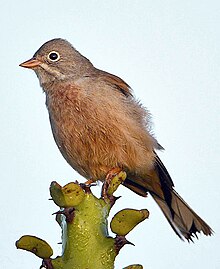Grey-necked bunting: Difference between revisions
| Line 24: | Line 24: | ||
==Habitat and distribution== |
==Habitat and distribution== |
||
[[Afghanistan]], [[Armenia]], [[Azerbaijan]], [[Bhutan]], [[China]], [[Hong Kong]], [[Sikkim]] [[Iran]], State of Israel,<ref>{{cite book|author=Yosef R|year=2001| chapter=Status and migration characteristics of buntings (Emberizidae) in Eilat and in Israel|title=Bunting studies in Europe|editors=Tryjanowski P, Osicjuk TS, Kupczyk M| publisher= Bogucki Wyd Nauk, Poznan|pages=11=18|url=http://www.birdsofeilat.com/pdfiles/2001%20Emb%20spp.%20Israel.pdf}}</ref> [[Kazakhstan]], [[Mongolia]], [[Oman]], [[Pakistan]], [[Russia]], [[Syria]], [[Tajikistan]], [[Turkey]], [[Turkmenistan]], and [[Uzbekistan]]. |
[[Afghanistan]], [[Armenia]], [[Azerbaijan]], [[Bhutan]], [[China]], [[Hong Kong]], [[Sikkim]], [[Iran]], State of Israel,<ref>{{cite book|author=Yosef R|year=2001| chapter=Status and migration characteristics of buntings (Emberizidae) in Eilat and in Israel|title=Bunting studies in Europe|editors=Tryjanowski P, Osicjuk TS, Kupczyk M| publisher= Bogucki Wyd Nauk, Poznan|pages=11=18|url=http://www.birdsofeilat.com/pdfiles/2001%20Emb%20spp.%20Israel.pdf}}</ref> [[Kazakhstan]], [[Mongolia]], [[Oman]], [[Pakistan]], [[Russia]], [[Syria]], [[Tajikistan]], [[Turkey]], [[Turkmenistan]], and [[Uzbekistan]]. |
||
Four subspecies have been named - nominate ''buchanani'', ''neobscura'', ''ceruttii'', and ''obscura''. |
Four subspecies have been named - nominate ''buchanani'', ''neobscura'', ''ceruttii'', and ''obscura''. |
||
Revision as of 19:39, 14 August 2010
| Grey-necked Bunting | |
|---|---|

| |
| Scientific classification | |
| Kingdom: | |
| Phylum: | |
| Class: | |
| Order: | |
| Family: | |
| Genus: | |
| Species: | E. buchanani
|
| Binomial name | |
| Emberiza buchanani Blyth, 1844
| |
| Synonyms | |
|
Euspiza huttoni | |
The Grey-necked Bunting or Grey-hooded Bunting (Emberiza buchanani) is a species of bird in the Emberizidae family. It breeds along a wide distribution range from the Caspian Sea to the Altai in Central Asia and winters in parts of Southern Asia. Like other buntings it is found in small flocks.
Description
This bunting has a long pink bill and is greyish above. The male has a distinctive white eye-ring that stands out in contrast to the grey hood. The chin and throat are whitish pink and they are bordered by grey malar stripes. The underparts are pinkish brown. The female is duller. The outer tail feathers are whitish.[2][3]
The species was described by Edward Blyth based on a drawing by Francis Buchanan-Hamilton after whom the species is named.[4] A supposed type specimen in the Indian Museum was never located.[5]
Habitat and distribution
Afghanistan, Armenia, Azerbaijan, Bhutan, China, Hong Kong, Sikkim, Iran, State of Israel,[6] Kazakhstan, Mongolia, Oman, Pakistan, Russia, Syria, Tajikistan, Turkey, Turkmenistan, and Uzbekistan.
Four subspecies have been named - nominate buchanani, neobscura, ceruttii, and obscura.
It is an extremely rare vagrant north of its' breeding range, with recent records from Finland and Holland, though wanderers may be overlooked due to its' similarity, in non-breeding plumage, to the closely related and far commoner Ortolan Bunting
They winter in parts of Africa, West Asia, extending to parts of South Asia occurring as far south as Sri Lanka.[7]
Its natural habitat is temperate grassland mainly below 7000ft.[8] In winter it is found in weedy or stubbly fields. It nests on the ground under some overhanging vegetation. The nest is lined with grass and hair. The song given from a perch is a series of short and shrill notes that increase in volume.[2]
An Ixodid tick Hyalomma turanicum has been recorded on birds from Kazakhstan.[9]
Claud Ticehurst noted that males and females migrated separately.[10]
References
- ^ Template:IUCN
- ^ a b Rasmussen PC & JC Anderton (2005). Birds of South Asia: The Ripley Guide. Volume 2. Smithsonian Institution & Lynx Edicions. pp. 553–554.
- ^ Oates, EW (1890). Fauna of British India. Birds. Volume 2. Taylor and Francis, London. p. 258.
- ^ Hellmayr CE (1929). Birds of the James Simpson-Roosevelts Asiatic Expedition. Vol. 17. p. 61.
{{cite book}}:|journal=ignored (help) - ^ Sclater, WL. "On the Indian Museum and its collection of birds". Ibis. 4 (series 6): 65–87.
- ^ Yosef R (2001). "Status and migration characteristics of buntings (Emberizidae) in Eilat and in Israel". Bunting studies in Europe (PDF). Bogucki Wyd Nauk, Poznan. pp. 11=18.
{{cite book}}: Unknown parameter|editors=ignored (|editor=suggested) (help) - ^ C. D. Kaluthota, Dammithra Samarasinghe, Dilshan de Silva, Hasith de Silva (2009). "First Record of the Grey-necked Bunting Emberiza buchanani from Sri Lanka" (PDF). Malkoha. 30 (1): 4.
{{cite journal}}: CS1 maint: multiple names: authors list (link) - ^ Carruthers, Douglas (1949). Beyond the Caspian. Oliver and Boyd. p. 107.
- ^ Hoogstral, Harry (1956). Ticks of the Sudan, Volume 1. US Naval Medical Research Unit 3, Cairo. pp. 528–530.
- ^ Baker, ECS (1926). Fauna of British India. Birds Volume 3 (2 ed.). Taylor and Francis, London. pp. 208–209.
External links

